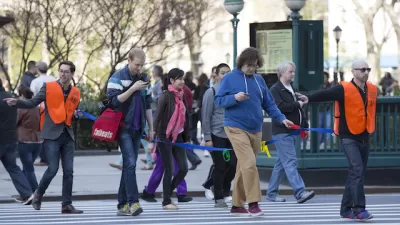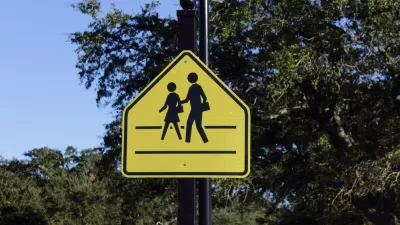It's serious, and the data is surprising. You need not be a pedestrian to experience injury while walking using your cell phone: half of all injuries occurred in the home. Two thirds of all walking-using-cell phone injuries were females.

Pedestrian fatalities were 15 percent higher in 2014 than they were in 2009, according to the February Governors Highway Safety Association report. Mobile devices undoubtedly play a role, though I didn't spot a percentage. The National Safety Council, a safety advocacy group, does provide some factual information though.
"As mobile devices have become more ubiquitous, the number of emergency room visits by distracted walkers has climbed steadily," writes Ashley Halsey III, transportation reporter for The Washington Post. "Some of the best information is a bit out of date, but it gives a sense of the trend. In 2005, 256 pedestrians injured while using phones received hospital treatment, a number that grew sixfold by 2010."
“It’s just really dangerous,” said Deborah Hersman, who heads the National Safety Council and is former chairman of the National Transportation Safety Board. “Everybody walking down the sidewalk either has their headphones on or is looking down at their phone. It’s a sad commentary on our society when you look at how distracted people are.”
Planetizen has covered this walking danger extensively - click on the "distracted walking" tag. While smart phones do pose a hazard to walking, they can also encourage walking by showing where interesting local destinations are located and how to get there without driving.
However, Halsey III's piece focuses exclusively on the threat that walking-while-distracted from cell phones pose. The data is still minimal, so he includes lots of anecdotal injuries.
"Some data suggests that at any given moment on the streets of America, 60 percent of pedestrians are distracted while walking, meaning either on the phone or doing something on their phone,” said Alan S. Hilibrand of the American Academy of Orthopaedic Surgeons. “It’s a bit of a startling number.”
But the public views that as acceptable behavior, not dangerous.
"A recent survey by the Pew Research Center found that Americans have grown comfortable using their mobile devices in public, and nowhere more so than “while walking down the street,” which 77 percent said was generally okay.
However, it's not okay, according to NSC.
"Distracted walking injuries involving cell phones accounted for an estimated 11,101 injuries between 2000 and 2011, making it a significant safety threat," they wrote in an earlier news release. "The trend is so alarming that it was included for the first time in the annual National Safety Council statistical report, Injury Facts®, which tracks data around the leading causes of unintentional injuries and deaths."
"Hersman said it’s hard for most people to ignore their phones," writes Halsey III.
“We’re dealing now with an addiction to these electronic devices that is, frankly, all-consuming,” she said. “When something beeps or buzzes or dings or vibrates, it really is as compelling as someone tapping you on the shoulder. People are being conditioned to engage in these activities and they get immediate gratification for that. Our brains get a hit of dopamine every time we open a message.”
FULL STORY: Eyes down, minds elsewhere, ‘deadwalkers’ are among us

Maui's Vacation Rental Debate Turns Ugly
Verbal attacks, misinformation campaigns and fistfights plague a high-stakes debate to convert thousands of vacation rentals into long-term housing.

Planetizen Federal Action Tracker
A weekly monitor of how Trump’s orders and actions are impacting planners and planning in America.

In Urban Planning, AI Prompting Could be the New Design Thinking
Creativity has long been key to great urban design. What if we see AI as our new creative partner?

Portland Raises Parking Fees to Pay for Street Maintenance
The city is struggling to bridge a massive budget gap at the Bureau of Transportation, which largely depleted its reserves during the Civd-19 pandemic.

Spokane Mayor Introduces Housing Reforms Package
Mayor Lisa Brown’s proposals include deferring or waiving some development fees to encourage more affordable housing development.

Houston Mayor Kills Another Bike Lane
The mayor rejected a proposed bike lane in the Montrose district in keeping with his pledge to maintain car lanes.
Urban Design for Planners 1: Software Tools
This six-course series explores essential urban design concepts using open source software and equips planners with the tools they need to participate fully in the urban design process.
Planning for Universal Design
Learn the tools for implementing Universal Design in planning regulations.
Gallatin County Department of Planning & Community Development
Heyer Gruel & Associates PA
JM Goldson LLC
City of Camden Redevelopment Agency
City of Astoria
Transportation Research & Education Center (TREC) at Portland State University
Jefferson Parish Government
Camden Redevelopment Agency
City of Claremont





























